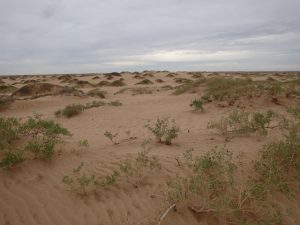
Dust storms are a common occurrence in the deserts of northern China, and has accumulated to great thicknesses to form the vast Chinese loess plateau. Researchers have attempted to locate the most important sources of this dust. It is important from a variety of environmental and health-related perspectives, and over longer time scales, it impacts climate change. A better understanding of the potential sources of dust can contribute to planning and mitigating the effects of the next dust storm or identify problem dust sources in the future.
Sand dunes, a common feature of many deserts, are composed almost entirely of sand and are usually ignored as dust sources. Recent research by scientists, including those in the U.K. and Israel, however, has revealed that sand grain collisions result in breaking and chipping of sand grains, highlighting a potentially important dust generation mechanism. In order to test whether sand dunes could produce substantial amounts of dust, Mark Sweeney, a dust researcher from the University of South Dakota, Huayu Lu and students from Nanjing University, and Joe Mason from the University of Wisconsin-Madison used portable wind tunnel technology, the Portable in situ Wind Erosion Laboratory (PI-SWERL), to measure the potential of dunes to emit dust in the Ulan Buh, Tengger, and Mu Us deserts of northern China in 2013.
The PI-SWERL, a technology developed by the Desert Research Institute in Las Vegas, Nevada, can measure the potential of dust emissions in places otherwise unaccessible to large field wind tunnels. Sweeney and colleagues conducted a number of tests on large, mobile transverse dunes, smaller, vegetated coppice dunes, and dry river and lake beds. High resolution particle size analysis revealed that the transverse dunes contained no dust-sized material, yet these dunes emitted low levels of dust. One explanation for this discrepancy is that dust was generated by the removal of grain coatings or breaking apart the grains themselves during grain collisions.
Coppice dunes, which are vegetated dunes that trap sand and dust-sized particles, emitted the most dust compared to all potential sources that they measured. The amount of dust emitted was similar to that emitted from dry river beds, which are considered important desert dust sources. Presently, the coppice dunes are not sources of dust because the vegetation prohibits the dust from being emitted. But if climate change, extended drought, or declining groundwater levels kill off the vegetation stabilizing these dunes, they can become large dust sources. Coppice dunes are very extensive in northern China.
This research emphasizes the importance of sand dunes as dust sources in the present and future and provides a more accurate picture of the types and variability of desert dust sources. A better understanding of dust sources can also lead to improved dust modeling efforts. Future work might expand on more types of dunes and determine the relative importance of grain coatings or grain chipping in dust formation.
Reference:
Mark R. Sweeney et al. Sand dunes as potential sources of dust in northern China, Science China Earth Sciences (2016). DOI: 10.1007/s11430-015-5246-8
Note: The above post is reprinted from materials provided by Science China Press.










